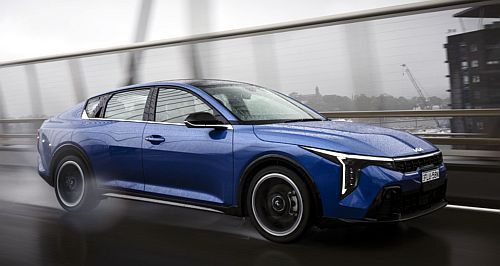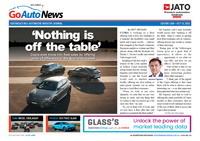Make / Model Search
New models - Kia - K4Kia K4 replaces outgoing CeratoPrice increases for Kia small car range as K4 arrives from $30,590 plus on-road costs16 Jan 2025 By NEIL DOWLING KIA has signed off on its linchpin passenger car, the Cerato, replacing it after a 21-year reign with an all-new sedan – and later this year, a hatch – under the K4 nameplate, starting at $30,590 plus costs.
The introduction of the K4, which uses the K preface to follow Kia’s global naming regime, brings a model that sits on a new platform, is longer, wider and lower than the Cerato and boasts a substantial upgrade in safety, but less so performance.
The K4 will go on sale later this month with the hatch expected to join towards the end of the year.
Kia this week said the K4 sedan range will be available in four grades: S, Sport, Sport+ and GT-Line.
Pricing starts at $30,590 (plus on-road costs), up $3530 on the car it replaces. The GT-Line costs $42,990 +ORC, up $6130.
Power units are the unchanged 2.0-litre aspirated four-cylinder engine and six-speed torque converter automatic for the S and Sport variants.
The GT-Line carries over the 1.6-litre turbocharged four-cylinder petrol engine but power is now 142kW/264Nm, down from the previous model’s 150kW/265Nm.
Fuel consumption averages remain unchanged at 7.4 litres per 100km for the 2.0-litre and 6.7L/100km for the turbo.
The GT-Line also gets a conventional torque converter automatic with eight ratios, replacing the seven-speed dual-clutch gearbox.
Speaking at the launch of the K4 in Melbourne this week, Kia Australia CEO Damien Meredith said the outgoing Cerato had been “a huge pillar of Kia’s success in Australia since its introduction in 2004”, the nameplate due to reach its 200,000th Aussie sale this month.
“We believe the K4 is a perfect fit for Australian tastes as the Cerato’s successor, complete with the right styling, technology, safety and driving characteristics to be competitive in this ever-changing landscape,” he said.
Kia presents the K4 with an upgraded safety inventory.
Across all grades, it has an increased focus on driver safety, with standard range fitment of forward collision-avoidance assist (FCA), ‘Smart’ cruise control (SCC) with ‘stop & go’ functionality, lane-keep assist (LKA), lane-follow assist (LFA), multi-collision braking (MCB), blind-spot collision avoidance assist (BCA), driver-attention warning (DAW), intelligent speed-limit assist (ISLA), rear-view monitor (RVM) and high-beam assist (HBA).
All K4 variants also get a full complement of airbags including a front centre-side airbag.
Kia said that a safety pack (not yet priced) is available on the S trim, extending buyers the option of additional equipment usually reserved for higher grades.
This includes an enhanced panoramic display which adds a second 12.3-inch instrument display and dedicated 5.0-inch HVAC interface, plus dual-zone climate control and an expanded AEB suite offering junction turning and crossing and direct/oncoming lane-change detection functionality.
Kia Australia’s chief ride and handling engineer, Graeme Gambold, said the K4 was adopted to Australia’s conditions and has a bespoke suspension and steering set up.
“We aimed to make it capable not only in the urban jungle but, also refined on a long drive,” he said.
“It does a great job absorbing bumps around town and controls its body well on challenging country roads, while offering decent feedback.
“We are confident the K4 matches its sportier looks out on the road, and Australians will appreciate the localised tuning.”
The Sport, Sport+ and GT-Line versions of the K4 also have Kia’s latest highway driving assist (HDA 2), a technology that functions when driving on a freeway or motorway.
Kia said that HDA builds on adaptive cruise control with stop-and-go capability, combining with lane-following assist (LFA) to keep K4 centred in the lane even when driving through a curve, whilst HDA 2 adds lane-change assist (LCA), allowing the K4 to autonomously change lanes when the required conditions are met.
Kia Australia said it is currently working with ANCAP as it completes its independent crash testing assessment, with an announcement and rating in due course.
The entry-level S has a digital driver cluster with a 4.0-inch multi-function LCD display (upgraded with the safety pack).
It also has Kia Connect, a connected car service which provides customer benefits in safety, security, convenience, connectivity, and LIVE services by using telematics systems to transfer real-time data, such as weather and traffic information.
In addition, it has ‘over the air’ (OTA) software updates, which brings the latest maps, interfaces and software enhancements without customers having to visit a service centre.
Wireless Apple CarPlay and wireless Android Auto are standard across the Kia K4 line-up, while the GT-Line takes things up a notch with fitment of a Qi wireless charging pad and ambient mood lighting as standard.
Kia said that it wanted the K4 to be approachable and easy-to-use “which is why the small car continues with a bank of hard-wired buttons and switchgear below the aforementioned screens on the dashboard centre fascia”.
Externally, the K4 has Kia’s latest ‘Opposites United’ design philosophy, including vertical front headlamps and daytime running light (DRL) elements located at the outer edges to accentuate the car’s wide stance.
It has flush second-row door handles integrated into the car’s C-pillar, and black wheel-arch cladding and wheel sizes ranging between 16-inch (S), 17-inch (Sport and Sport+) and 18-inch (GT-Line).
Dimensionally, the K4 measures 4710mm long, 1850mm wide and 1425mm high, and rides on a 2720mm wheelbase. In comparison to the Cerato sedan, these are 200mm longer and the wheelbase is up 20mm. The K4 sedan weighs between 10kg and 38kg compared with the Cerato.
Kia said that inside those dimensions convert to roomier interior proportions, especially with respect to rear seat space, where rear legroom has grown by 56mm. Front-row occupants also benefit from increased head and shoulder room proportions.
Additionally, the K4 boasts an increase in boot space over its immediate predecessor, with sedan variants offering a 508-litre layout. The Cerato sedan had 502 litres.
S and Sport variants have cloth seats, while Sport+ and GT-Line get artificial leather.
GT-Line projects a sportier image, with embossed GT-Line details on seats, two-tone seats, and textured console crash pad. It also has a sliding-type sunroof.
The K4 embraces Kia’s ongoing efforts in sustainability, incorporating the use of the brand’s 10 ‘must-have’ sustainability items, including PP and Bio PE plastic, Post Consumer Material (PCM), Bio PU Leather, Bio PU foam, Bio Paint, BTX-free Paint, Recycled PET Yarns, and Recycled PET Felt.
The K4 arrives in Australia with a choice of eight exterior colours. New to the colour palette are Interstellar Grey, Fiery Red, Wave Blue, and Honeydew.
They join the familiar hues of Clear White, Snow White Pearl, Steel Gray and Aurora Pearl Black ($600 for Premium Paint applies to all but Clear White).
2025 Kia K4 pricing*:
*Pricing excludes on-road costs.  Read more15th of January 2025  Details firm on Kia EV3Compact all-electric Kia EV readies for Australian launch in Q2 this year15th of January 2025  Updated Kia EV6 shown in MelbourneDue here in Q2 the facelifted Kia EV6 adds connectivity, larger battery9th of January 2025  Kia Australia reveals plans for ‘25Holds with a predicted 20,000 Tasman sales rate despite negative market responseAll new models Alfa Romeo Alfa Romeo Abarth Abarth Audi Audi Aston Martin Aston Martin BMW BMW Bentley Bentley Chrysler Chrysler Chevrolet Chevrolet Dodge Dodge Citroen Citroen Ferrari Ferrari DS DS Ford Ford Fiat Fiat FPV FPV Foton Foton Haval Haval Great Wall Great Wall Honda Honda Holden Holden Hyundai Hyundai HSV HSV Isuzu Isuzu Infiniti Infiniti Jaguar Jaguar Iveco Iveco Kia Kia Jeep Jeep Land Rover Land Rover Lamborghini Lamborghini Maserati Maserati Lexus Lexus McLaren McLaren Mazda Mazda Mercedes-Benz Mercedes-Benz Mitsubishi Mitsubishi Mini Mini Opel Opel Nissan Nissan Porsche Porsche Peugeot Peugeot Ram Ram Proton Proton Rolls-Royce Rolls-Royce Renault Renault Skoda Skoda Saab Saab SsangYong SsangYong Smart Smart Suzuki Suzuki Subaru Subaru Toyota Toyota Tesla Tesla Volvo VolvoMotor industry news |
|











Facebook Twitter Instagram